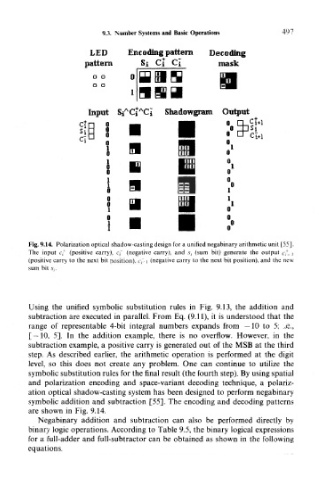Page 512 - Introduction to Information Optics
P. 512
9.3. Number Systems and Basic Operations 497
LED Encoding pattern Decoding
pattern Si Cl d mask
o o 0 Has
o o
FISH
A
A
Input Si Ci Ci Shadowgram Output
Fig. 9.14. Polarization optical shadow-casting design for a unified negabinary arithmetic unit [55].
The input c* (positive carry), c^ (negative carry), and .s, (sum bit) generate the output c/t,.,
(positive carry to the next bit position), cf+ } (negative carry to the next bit position), and the new
sum bit s,-.
Using the unified symbolic substitution rules in Fig. 9.13, the addition and
subtraction are executed in parallel. From Eq. (9.11), it is understood that the
range of representable 4-bit integral numbers expands from —10 to 5; i.e.,
[ — 10, 5]. In the addition example, there is no overflow. However, in the
subtraction example, a positive carry is generated out of the MSB at the third
step. As described earlier, the arithmetic operation is performed at the digit
level, so this does not create any problem. One can continue to utilize the
symbolic substitution rules for the final result (the fourth step). By using spatial
and polarization encoding and space-variant decoding technique, a polariz-
ation optical shadow-casting system has been designed to perform negabinary
symbolic addition and subtraction [55]. The encoding and decoding patterns
are shown in Fig. 9.14.
Negabinary addition and subtraction can also be performed directly by
binary logic operations. According to Table 9.5, the binary logical expressions
for a full-adder and full-subtractor can be obtained as shown in the following
equations.

